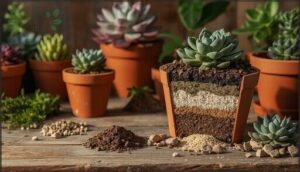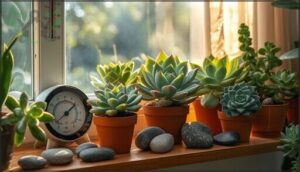This site is supported by our readers. We may earn a commission, at no cost to you, if you purchase through links.
Succulents have earned their reputation as resilient plants, but that doesn’t mean they’re indestructible. The truth is, more succulents die from well-meaning overwatering than from neglect. These desert-adapted plants store water in their thick leaves and stems, which means caring for succulent plants requires you to rethink everything you know about traditional houseplant care.
Their survival strategy—hoarding moisture for dry spells—becomes their downfall when we treat them like thirsty tropicals. Understanding how succulents actually function in their native habitats transforms the way you approach their care.
When you match your watering schedule, light exposure, and soil conditions to their evolutionary adaptations, these plants reward you with vibrant colors, compact growth, and years of low-maintenance beauty.
Table Of Contents
- Key Takeaways
- Choosing The Right Succulent Plants
- Providing Optimal Light and Placement
- Watering Succulents Properly
- Selecting Soil and Containers
- Maintaining Ideal Temperature and Humidity
- Fertilizing and Pruning Succulents
- Preventing and Managing Pests and Diseases
- Frequently Asked Questions (FAQs)
- Conclusion
Key Takeaways
- Succulents die more often from overwatering than neglect because their water-storing tissues evolved for drought conditions, making them vulnerable to root rot when treated like moisture-loving houseplants.
- The soak-and-dry watering method—thoroughly saturating soil until it drains, then waiting until completely dry before watering again—mimics natural desert rainfall cycles and prevents the most common cause of succulent failure.
- Proper light exposure of 4-6 hours daily prevents etiolation (leggy, stretched growth), while well-draining soil with 60-80% mineral content like perlite or pumice is essential for healthy root development.
- Temperature ranges between 60°F and 80°F with humidity levels of 40-50% create optimal growing conditions, though succulents tolerate wider ranges when properly acclimated and protected from extreme weather.
Choosing The Right Succulent Plants
Before you bring home your first succulent, it’s worth taking a minute to think about where you’ll keep it and who else shares your space.
Not all succulents thrive in the same conditions, and some varieties can be harmful to curious pets.
Here’s what you need to know to pick plants that’ll actually work for your situation.
Popular Indoor and Outdoor Varieties
Succulent varieties offer striking diversity for both indoor adaptability and outdoor landscaping. Your choice depends on available space, light conditions, and aesthetic goals. Well-drained soil is essential for preventing root rot.
Popular options include:
- Aloe vera – Indoor medicinal favorite, grows to 2 feet
- Jade Plant – Decades-long indoor companion with glossy leaves
- Agave – Outdoor statement piece with drought resistance
- Sedum – Adaptable outdoor bloomer with decorative appeal
Selecting Succulents for Your Climate
Your climate determines whether outdoor succulents thrive or simply survive. Check your Hardiness Zone—cold-hardy Sedum and Sempervivum tolerate frost down to -20°F in zones 3-5, while Agave prefers zones 9-10.
Regional succulents adapted to arid climates need well-draining soil and low humidity. For year-round beauty, consider planting cold hardy succulents in your outdoor garden.
High humidity above 50% invites rot, so consider microclimate options like south-facing walls or indoor succulents with proper ventilation.
Pet-Safe Succulent Options
When you share your home with pets, safe species ID matters. Echeveria, Haworthia, and Sempervivum pose zero toxicity risk to cats and dogs, while Jade Plant and Kalanchoe trigger vomiting or lethargy. Around 70-80% of common succulents are nontoxic plants, so you’ve got options.
Use placement strategies—high shelves, hanging planters—and consider veterinary consultation before introducing new varieties. Pet safety doesn’t mean sacrificing beauty.
Keep toxic succulents out of reach with high shelves and hanging planters—pet safety and beauty can coexist
Providing Optimal Light and Placement
Light is everything for keeping your succulents healthy and compact. Without the right amount and quality of sunlight, even the hardiest varieties will struggle, stretch, or lose their vibrant colors.
Let’s walk through how to meet their light needs, whether you’re working with windowsills or grow lamps.
Sunlight Requirements for Succulents
Most succulents need 4 to 6 hours of direct sunlight daily to thrive and maintain compact growth. Species like Echeveria prefer full sun exposure, while Haworthia and Gasteria do better with bright indirect light.
To prevent leaf burn, gradually introduce your plants to stronger sun through an acclimation process. Understanding each species’ light requirements helps you provide ideal conditions and avoid sunburn damage.
Using Grow Lights Indoors
When natural bright indirect light falls short, grow lights become your indoor gardening ally. Full spectrum LED options deliver the light requirements succulents need while keeping energy consumption low—usually running 10-12 hours daily.
To get the best results:
- Position your grow light 12 inches from plant tops to balance light distance and intensity
- Rotate your succulents weekly for even light exposure
- Begin with 6 hours daily, gradually increasing during the acclimation period
Preventing Leggy Growth
When your succulent starts reaching awkwardly for light, you’re witnessing etiolation—leggy growth caused by light deprivation. To prevent this stretching:
| Issue | Solution | Impact |
|---|---|---|
| Insufficient sunlight | 6+ hours bright light daily | Prevents weak stems |
| Watering imbalance | Soak-and-dry method | Strengthens plant growth |
| Temperature stress | Maintain 60-80°F | Reduces elongation |
Regular pruning and proper airflow combat nutrient deficiency while encouraging compact development.
Watering Succulents Properly
Watering is where most succulent owners go wrong, but it doesn’t have to be complicated once you understand how these plants use water. The key is mimicking the natural wet-dry cycles of their native environments rather than following a strict schedule.
Let’s break down the proper watering approach, warning signs to watch for, and how to adjust your routine throughout the year.
Soak and Dry Watering Method
You’ve probably seen succulents thrive, then suddenly die—often from watering mistakes. The soak and dry method prevents this by mimicking natural desert rainfall: thoroughly saturate the soil until water drains freely, then wait until it’s completely dry before watering again.
This approach helps you:
- Prevent root rot by avoiding prolonged soil saturation
- Develop stronger, deeper root systems
- Adjust watering frequency for seasonal needs naturally
- Revive dehydrated succulents effectively
Master these watering techniques, and your plants will reward you.
Recognizing Overwatering and Underwatering
When watering succulents, your plants speak through visible symptoms—you just need to read them. Overwatering produces soft, mushy, translucent leaves that yellow and drop easily, often accompanied by root rot with blackened, foul-smelling roots. Underwatering shows wrinkled, shriveled leaves with brown, crispy edges and aerial roots seeking moisture.
Check soil moisture and root health regularly, adjusting watering frequency based on these growth indicators.
Adjusting Watering by Season
Your succulent’s watering schedule isn’t one-size-fits-all—it shifts dramatically with the seasons. During dormancy in fall and winter, reduce watering frequency to once every 3-4 weeks, while the growing season demands an increase to every 7-10 days.
Monitor these seasonal indicators:
- Temperature changes between 15-25°C signal active growth periods
- Varietal adaptations like drought-tolerant cacti versus moisture-loving Jade plants
- Potting influence through terracotta’s faster moisture evaporation
- Humidity impact on indoor versus outdoor succulent care guide requirements
Selecting Soil and Containers
Getting the foundation right makes all the difference when growing succulents. Your soil mix and container choice directly affect drainage, root health, and overall plant success.
Here’s what you need to know about creating the ideal growing environment for your succulents.
Best Soil Mixes for Succulents
The best soil for succulents isn’t your typical potting soil—it needs a specialized composition that balances drainage needs with proper moisture retention. You’ll want a mix containing 60-80% mineral content like perlite or lava rock, combined with organic matter for nutrients.
Well-draining soil prevents root rot, while maintaining pH balance between 5.5 and 6.5 encourages healthy root development.
Improving Drainage With Amendments
Even the right soil blend sometimes needs a boost. Perlite effectiveness shines when mixed 1:1 with potting soil—it cuts water retention by over 30% and improves aeration dramatically. Pumice application at 25% volume accelerates drainage, while coarse sand (never fine) works wonders in clay-heavy mixes.
Vermiculite use helps by expanding when wet, and coco coir offers renewable moisture control for humid climates.
Choosing Pots With Drainage Holes
After prepping your soil mix, the container you choose matters just as much. Drainage holes prevent root rot by cutting water retention up to 45%—look for at least one hole per pot, 0.5 to 1.25 inches across. Terracotta pots naturally wick moisture, while ceramic offers style without sacrificing function. Need more holes? DIY drainage solutions with a masonry bit work perfectly on most materials.
Maintaining Ideal Temperature and Humidity
Succulents can handle a range of conditions, but they’ll reward you with vigorous growth when temperature and humidity fall within their comfort zone.
Getting these factors right isn’t complicated, though it does require some attention to your indoor environment and seasonal changes. Here’s what you need to know to keep your plants thriving year-round.
Temperature Ranges for Healthy Growth
Most succulents thrive when you maintain temperatures between 60°F and 80°F, though they’ll tolerate ranges from 45°F to 85°F without complaint. Good temperatures for strong growth usually fall within this comfortable zone, mimicking their native habitats.
Your plants prefer cooler nights than days—this natural fluctuation encourages healthy development.
Temperatures below 40°F risk frost damage, while sustained heat above 90°F can stress even heat-adapted varieties.
Managing Humidity Indoors
Indoor succulents prefer humidity levels between 40% and 50%—drier than most houseplants. If your home feels muggy, humidity can slow soil drying and invite fungal problems.
Use a dehumidifier to maintain ideal conditions, or position an oscillating fan near your plants to boost air circulation.
Grouping succulents together creates a microenvironment with moderated humidity levels, helping you avoid watering adjustments while keeping your collection healthy.
Protecting Succulents From Extreme Weather
When temperatures swing too far in either direction, your succulents need backup. Extreme weather demands quick action to prevent permanent damage.
Follow these protective strategies:
- Cover frost-sensitive plants with burlap or frost cloth when temperatures drop below 40°F
- Use 30% shade cloth during heatwaves to shield against UV damage
- Water in evening hours during heat stress to support temperature regulation
- Keep soil dry in cold weather—moisture plus freezing equals root rot
Remove covers once conditions stabilize.
Fertilizing and Pruning Succulents
Succulents don’t need much fertilizer, but giving them a light feeding during their growing season can make a real difference in their vigor and color.
Beyond feeding, occasional pruning keeps your plants compact, removes damaged tissue, and even opens up opportunities to propagate new succulents from the cuttings.
Here’s how to approach both fertilizing and pruning to keep your collection healthy and thriving.
When and How to Fertilize
Fertilizing succulents during their active growth period—spring through summer when temperatures exceed 60°F—promotes stronger root development and healthier plants.
You’ll want a balanced, low-nitrogen fertilizer with NPK ratios like 9-3-6, applied monthly at quarter-strength to prevent over-fertilization.
Always moisten the soil before fertilizer application to avoid root burn, and skip feeding during fall and winter dormancy when nutrient requirements decrease substantially.
Pruning for Health and Shape
During early spring or fall, you’ll want to prune stretched stems back to healthy growth points using sterilized shears—this pruning timing removes diseased sections, improves air circulation, and shapes succulents into compact forms.
Cut above leaf nodes to stimulate bushier plant growth, then wait 5–7 days before watering to let cuts callus and prevent infection.
These aftercare tips guarantee healthy plant health.
Encouraging New Growth
Want your succulents to multiply and flourish? Strategic care during the growing season makes all the difference.
- Fertilize monthly with diluted liquid fertilizers (10-10-10 NPK ratio) during spring and summer
- Remove offsets carefully to propagate new plants while encouraging mother plant vigor
- Manage light exposure by providing 6-8 hours of bright, indirect sunlight daily
Combine thoughtful pruning methods with proper soil amendments to stimulate vigorous, healthy growth throughout the season.
Preventing and Managing Pests and Diseases
Even healthy succulents can face threats from pests and diseases, especially when growing conditions aren’t quite right. The good news is that most problems are preventable with proper care, and early detection makes treatment much simpler.
Let’s walk through how to spot common issues, address them effectively, and keep your plants thriving long-term.
Identifying Common Succulent Pests
You’ll notice several troublesome pests on succulents if you inspect regularly. Mealybugs appear as fuzzy white clusters along stems and leaf veins, while scale insects look like small domes with hard shells. Spider mites create fine webbing and stippled leaves, and aphids cluster on tender growth, secreting sticky honeydew.
Don’t overlook rodent damage—mice can bite plants into pieces. Treat infestations quickly with neem oil or insecticidal soaps.
Treating Fungal and Bacterial Issues
Fungal identification starts with spotting pale, sunken spots or dark rot on leaves and stems. Bacterial infections spread fast through water contact, so isolate affected plants immediately. Treatment options vary by pathogen—copper fungicides work well for rust disease, while mancozeb combats Fusarium rot.
Prevention methods include:
- Use well-draining soil to prevent root rot
- Apply neem oil or fungicides at first signs
- Remove infected leaves promptly
- Improve air circulation around plants
- Choose resistant species when possible
Tips for Ongoing Plant Health
Regular growth monitoring catches problems early—check your plants weekly for color changes or unusual patterns. Root inspection during repotting reveals hidden issues before they escalate.
Adjust watering practices seasonally, remembering your succulents need less during dormancy care periods. Repotting frequency depends on growth rate, usually every 2–3 years.
These simple houseplant care habits strengthen plant health and prevent most maintenance headaches.
Frequently Asked Questions (FAQs)
How do I propagate succulents from leaves or cuttings?
The easiest way to multiply succulents is also the trickiest—propagation through leaf cuttings succeeds roughly half the time, while stem cuttings root more reliably.
Allow cuts to callus, use rooting hormones, and propagate during spring for best results.
When should I repot my succulent plant?
You’ll want to repot succulents every two years, ideally in early spring or fall.
Watch for roots poking through drainage holes, stunted growth, or soil that dries too quickly—these visual cues signal it’s time to transplant.
Can succulents survive outdoors during winter months?
Like a winter coat shields you from freezing winds, hardy succulents need the right protection and Species Selection for Winter care. Hardiness Zones determine Frost tolerance; Regional Adaptation and Snow Insulation help Outdoor succulents survive through proper Winter Protection strategies.
Why are my succulent leaves turning brown?
Brown leaves can signal various issues, including overwatering signs like root rot, sunburn from intense light, underwatering symptoms such as desiccation, pest identification issues, or poor water quality.
Check your watering habits, sunlight exposure, soil drainage, and inspect for pests carefully.
Do succulents need different care when flowering?
Yes, flowering succulents need adjustments. Increase watering frequency during the growing season, provide stronger light intensity, use high-phosphorus fertilizer monthly, maintain temperature stability, and monitor for increased pest vulnerability around blooms.
Conclusion
Like a well-tuned instrument that performs beautifully when each component works in harmony, caring for succulent plants succeeds when you balance light, water, soil, and environmental conditions. These adaptable plants don’t demand flawlessness—they require consistency aligned with their desert origins.
By respecting their unique biology and adjusting your approach to mirror their natural habitat, you’ll cultivate thriving succulents that display vibrant colors, strong structural integrity, and resilient growth for years to come.
- https://www.accio.com/business/succulent_trend
- https://debraleebaldwin.com/uh-oh-succulent-sick/
- https://www.plantsforallseasons.co.uk/blogs/succulent-care/succulent-sunlight-requirements-a-complete-guide
- https://thenextgardener.com/blogs/news/soil-types-for-diy-succulent-projects-with-recipe
- https://www.thezensucculent.com/blog/leggy-houseplants-causes-and-solutions












